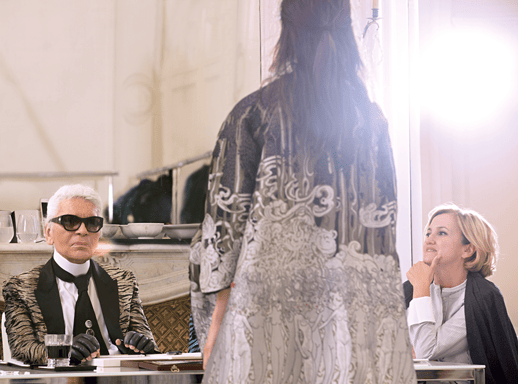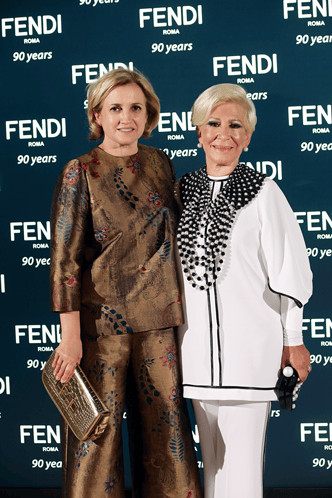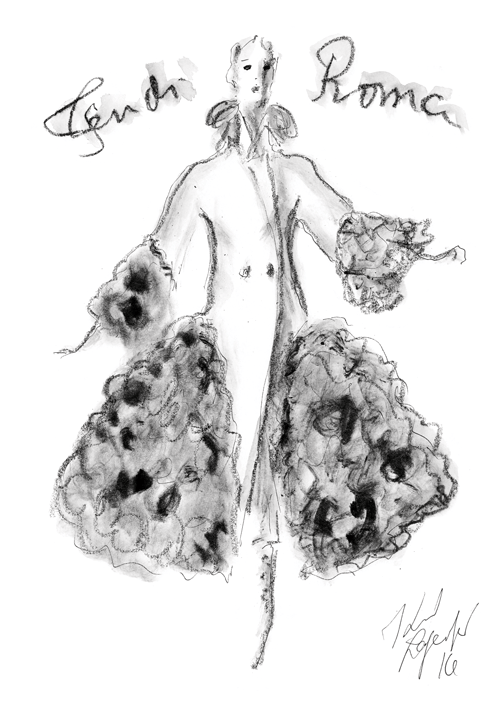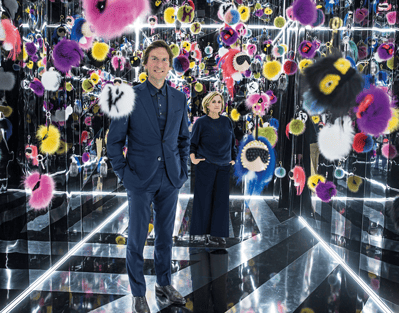
Karl Lagerfeld and Silvia Venturini Fendi, the two icons shaping Fendi’s legacy today
Ninety glorious, eventful years make an epic tale, but for Fendi, which forms its mindset after the Roman god Janus with one eye on the past and the other on the future, it’s a never-ending story. “Well, for me, it’s normal,” says Silvia Venturini Fendi, creative director of accessories and menswear, and third-generation scion, when we meet again for what I call, another “anniversary interview” (the previous being the 80th and 85th, also in Rome). “But I understand when I talk to people, that they want to know more about the story of my family. It’s interesting especially because it’s a very real story.”

Silvia Venturini with her mother, Anna Fendi
“Ninety is part of a big path that we’ve been doing,” she shares. “I feel so proud of what we have been achieving and if I go back, I see everything and how Fendi has grown, the goal that we have been reaching, and I think my grandparents would be happy to see that. My grandfather always said, as my mother tells me, that Fendi will become a very famous name. He was sure of that. And my grandmother, my mother, her sisters (my aunts), were really committed to make it happen. I’m the only one who is still in the business but the others are really big supporters of what Fendi is today.” Her unique position, of being part of a great legacy and yet creating fresh history each season, is what gives it remarkable dynamism. She is perhaps the only fashion executive in the world still working for her namesake brand, and these are her stories.

A Fendi haute fourure sketch
On working at Fendi 25 years ago, and now
The passion and the creative work is basically the same; of course, the speed is more demanding, but we have different tools. The Internet has inspired us. Now, when we have an idea, we would see something and go deep in research, but with images. Also, the relationship with Karl that started 50 years ago is so different. Back then, they had to deal with the long distance phone call from Paris to Rome. He used to send packages with information inside—sketches, books, and little pieces of things as inspiration. Today, we talk to each other by iPhone and messages, and we really go into the details. It is much more easier, faster, and practical. But we still put the same attention and work.

With Pietro Beccari, CEO of Fendi, in the ‘Obsession’ room of 300 bag bugs
Fendi 90 years on
Of course, Fendi has been growing and growing. This is something that we really wanted to happen; the family decided to sell it to LVMH because times were changing—globalisation was happening—and to be successful, we needed a group with different skills and was more international. We were sure they are the best because we saw the work in Louis Vuitton, for instance. They’ve kept the tradition alive, the roots are preserved, and how fast they are in implementing things. We were sure that these would happen to Fendi, and today, we are here. For the next 90 years, there is so much to grow; but the base, the past, is very important.
On working with Karl Lagerfeld
I met him when I was 5 years old … everytime Karl was in Rome, there was no way of disturbing her [my mother] and nothing could happen when he was around. And being a little girl, I immediately understood that was much more exciting than being in school or being at home with my sisters or with my friends playing with toys. I hoped something more interesting was happening at the atelier so I used to always be there, witnessing and looking, and learning. And so the relationship [with Karl] grew and it’s a very natural kind of relationship.We both know Fendi very well—it’s a company made by women, by my mother, her sisters, but also by an incredible man who is Karl. And so we have the same vision; we are so dedicated, we have been so involved in the creation of what it is. For us, it is quite easy to say, “Oh, this is Fendi. This is not.” When he has an idea, I know what he expects from us and you know Karl is someone who wants the best and is used to the best. He finds this here, we know it.
On being at the heart of Fendi
Today, I still feel like it belongs to me, like it always has because it’s an emotional attachment. I was raised and always thinking about what we can do for the company. It doesn’t have anything to do with stock options. At the same time, I am always using it navigationally. Sometimes when I travel and arrive in a city that I don’t know and see a shop with my name on it, I feel at home.

‘Legends and Fairytales’ at the Trevi fountain
On balancing heritage with playfulness
It’s very Roman. Because Romans are very spoilt in terms of beauty as they are in excess. So, the approach, especially when you deal with such important materials and such luxurious fabrics and fur, for instance, which is the most expensive one, is to have it kind of in a snobbish way. Like it’s nothing, like a piece of cloth. That’s why sometimes you see in Rome that there is a big neglect. We have so much that in the end, it’s nothing “museum”. We want to see the real side of it because to live in a museum, it’s not easy. Here, you think you should wear slippers to walk on stones in Rome, but because the Romans are so used to everything as they’ve seen so much, they approach things with a wicked sense of humour and a certain detachment. That’s what our take is on being a Roman brand.
On the next generation
The company is not family-owned anymore, but when you are born in a certain environment, you learn. My daughter [Delfina Delettrez, the jewellery designer] has a very good sense of style, so that’s why she’s growing successfully. The creativity is in the genes … there is already a new generation because Delfina’s daughter, Emma, who is 9 years old now, goes to her mother’s atelier, and makes jewellery every Wednesday.
On designing fur
Fur connects you to the roots. It’s the most primitive garment. In the legends, fur means strength to the warriors and emperors. When you wear fur, you feel powerful and yet very sensual. Now, we do a lot of summer fun because in tropical countries, the air conditioning is so strong. And we do organza mixed with fur, which is so nice. Human beings like fur for this reason—to see things that reconnect us to our roots.
On Fendi moving toward being 100 years
I imagine we will go to the moon [laughs]. No, we will have to start thinking, but something impossible will happen for sure. We will surprise you, don’t worry.



